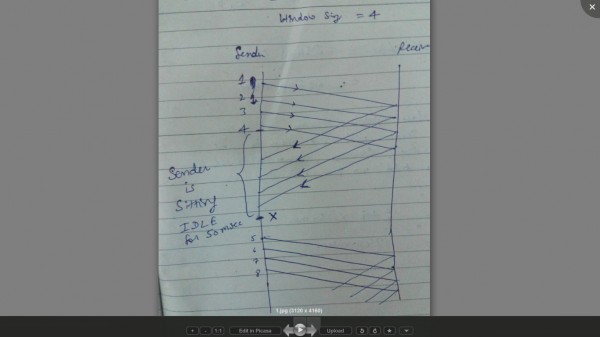Since we are asked to ignore transmission time , waiting and processing delays etc..so in overall we have to consider propagation time only
Propagation time (sender to receiver) = 5000 / 2*(10^8)
= 25 msec.
RTT = 2*25 = 50 msec
No. of packets = 10^6 / 10^3
= 1000 packets
Total time = propagation time for data + propagation time for ack
Case 1 :
In stop and wait, sender window size = 1 …now when ack of first packet will reach to sender then only sender will send next.
Hence, time for one packet = 25 + 25 = 50msec
Time for 1000 packets = 50*1000 = 50000 msec
CASE 3 : lets talk about selective repeat then we will talk about go back afterwards :
first just go through the diagram...in this four packets will go at a time..since no transmission time etc only propagation time..

After sending 4 packets now sender will sit idle for 50 msec (i.e RTT) and then the at POINT " X " sender's window will again become ready to send 4 more packets. HENCE in group of 4 , packets will be sent same process will repeat (like sender will wait for another 50 msec.).
No. of times sender is sitting idle = 1000/4
=250
NOTE : when last 4 packets will be sent then sender will not have to wait for 50 msec because we are told no packet is lost or demaged. so sender will not wait for ack.
hence time = 249 * 50msec = 12450 msec.
CASE 2 lets talk about GO BACK N ;
HERE also NO DIFFERENCE same as previous . The only difference is for 7 packets only 1 ACK will come to sender but that also will consume same propagation time .
No. of times sender will sit idle = 1000/7
= 143
BUT we will take 142 times only...reason for this is the same explanation given in NOTE i have given above (in the case 3)
so, time = 142 * 50msec
= 7100 msec
FINAL ANSWERS ; case 1 - 50,000 msec
case 2 - 7100 msec
case 3 - 1240 msec
any queries are welcomed in comments...!!! hope its clear..!!